Copy trading has evolved into a vital tool for professional traders managing multiple accounts, especially in fast-moving markets like futures, forex, and cryptocurrency. By 2025, platforms have become more precise, leveraging API integrations, cloud-based systems, and low-latency hosting to ensure trades are mirrored instantly and efficiently. Whether you’re a prop firm trader, algorithmic developer, or portfolio manager, these platforms cater to scaling strategies across accounts while maintaining strict risk controls.
Key Takeaways:
- Top Platforms: NinjaTrader, Quantower, MetaTrader 4/5, TradeStation, Sierra Chart, and cTrader Copy.
- Features: API-based trade replication, cloud hosting, multi-asset support, and proportional risk management.
- Use Cases: Ideal for prop firm traders (e.g., Apex, MFFU, FundedNext), algorithmic trading, and portfolio scaling.
- Performance: Execution speeds under 100ms with tools like TradeSyncer and CrossTrade.
- VPS Hosting: High-performance VPS (e.g., QuantVPS) ensures low latency and uninterrupted trading.
Quick Comparison:
| Platform | Best For | Latency | Assets Supported | Hosting |
|---|---|---|---|---|
| NinjaTrader | Futures, Prop Firms | 0-50ms | Futures, Forex | VPS/Cloud |
| Quantower | Multi-Account Management | <100ms | Forex, Futures, Crypto | QuantVPS |
| MetaTrader 4 (MT4) | Forex-Focused Traders | 0-50ms | Forex, CFDs | VPS |
| MetaTrader 5 (MT5) | Multi-Asset Traders | 0-50ms | Forex, Stocks, Futures, Crypto | VPS |
| cTrader Copy | Strategy Providers | 0-50ms | Forex, Commodities, Crypto | Built-In Cloud |
| TradeSyncer | Futures Professionals | <200ms | Futures | Cloud |
Modern platforms ensure precise trade replication while offering flexibility for diverse trading needs. Whether you’re scaling strategies across funded accounts or managing portfolios, these tools deliver the performance and reliability required for success.
How I Use Trade Copiers to Trade Multiple Prop Accounts
1. NinjaTrader

NinjaTrader is a popular platform designed for professional futures trading. It integrates with third-party cloud-based trade copiers through its API, allowing traders to replicate trades and manage risks across multiple accounts. This setup provides flexibility, enabling users to choose specialized tools that streamline multi-account replication for funded accounts.
Thanks to its open architecture, NinjaTrader works seamlessly with advanced copy trading tools like Replikanto, CrossTrade, Affordable Indicators Trade Copier, and ETP Trade Copier. These tools transform the platform into a robust system for replicating strategies on a larger scale while enhancing performance and risk management.
Copy Mechanism (Network and API-Based)
NinjaTrader supports copy trading through network and API-based systems, connecting master and follower accounts via cloud infrastructure. For instance, TradeSyncer synchronizes trades from a single leader account to multiple follower accounts in real time, leveraging a global network. Similarly, Traders Connect, a cloud-based tool with planned NinjaTrader support, ensures uninterrupted synchronization between master and follower accounts, even without relying on local hardware. This cloud-driven approach ensures reliability and efficiency for copy trading.
Supported Assets (Futures and Forex)
NinjaTrader is particularly strong in futures trading, offering access to major exchanges like CME, CBOT, NYMEX, and ICE. It supports widely traded contracts such as ES (S&P 500), NQ (Nasdaq), and YM (Dow Jones), ensuring precise execution for these instruments. The platform also supports forex trading through various broker integrations, making it a versatile choice for professional traders handling different asset classes.
Latency and Execution Speed
Fast and reliable execution is vital for successful copy trading, and NinjaTrader delivers on this front through its third-party tools. Solutions like TradeSyncer and Traders Connect provide execution speeds as fast as 20–30 milliseconds, with most trades completing in under 100 milliseconds. This speed is especially critical for high-frequency trading strategies.
Ideal Use Case (Prop Firms and Algorithmic Traders)
NinjaTrader’s copy trading ecosystem is a great fit for proprietary (prop) firm traders who need to replicate strategies across multiple funded accounts. Tools like TradeSyncer are widely used by traders working with firms such as Apex, MFFU, or FundedNext, ensuring smooth and reliable futures trading. Algorithmic traders also benefit greatly from NinjaTrader’s comprehensive strategy development tools, which allow them to create, test, and deploy strategies while managing risk proportionally. For those managing several personal prop firm accounts, Traders Connect provides reliable synchronization, ensuring consistent trading and effective risk management.
2. Quantower
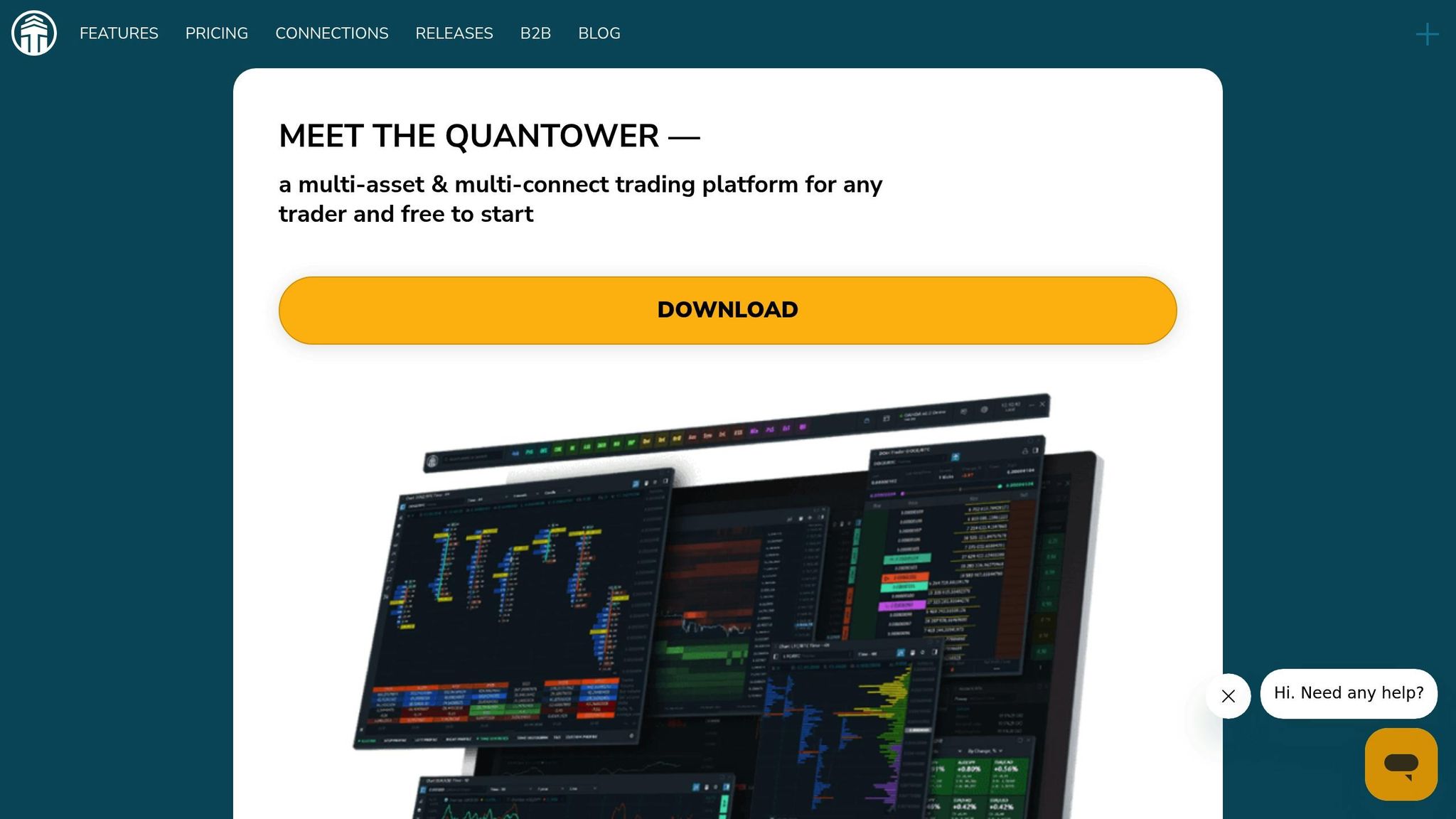
Quantower is a trading platform tailored for professionals, offering support for multiple brokers and advanced features. One standout feature is its built-in copy trading functionality, which allows traders to oversee and manage multiple accounts from a single, unified interface.
This platform simplifies the complexities of multi-account management, making it a strong choice for professional traders. When combined with a high-performance VPS hosting solution like QuantVPS, users can enjoy enhanced connectivity and reliable uptime. With its powerful interface and comprehensive tools, Quantower provides everything needed for sophisticated copy trading strategies.
3. MetaTrader 4 (MT4)
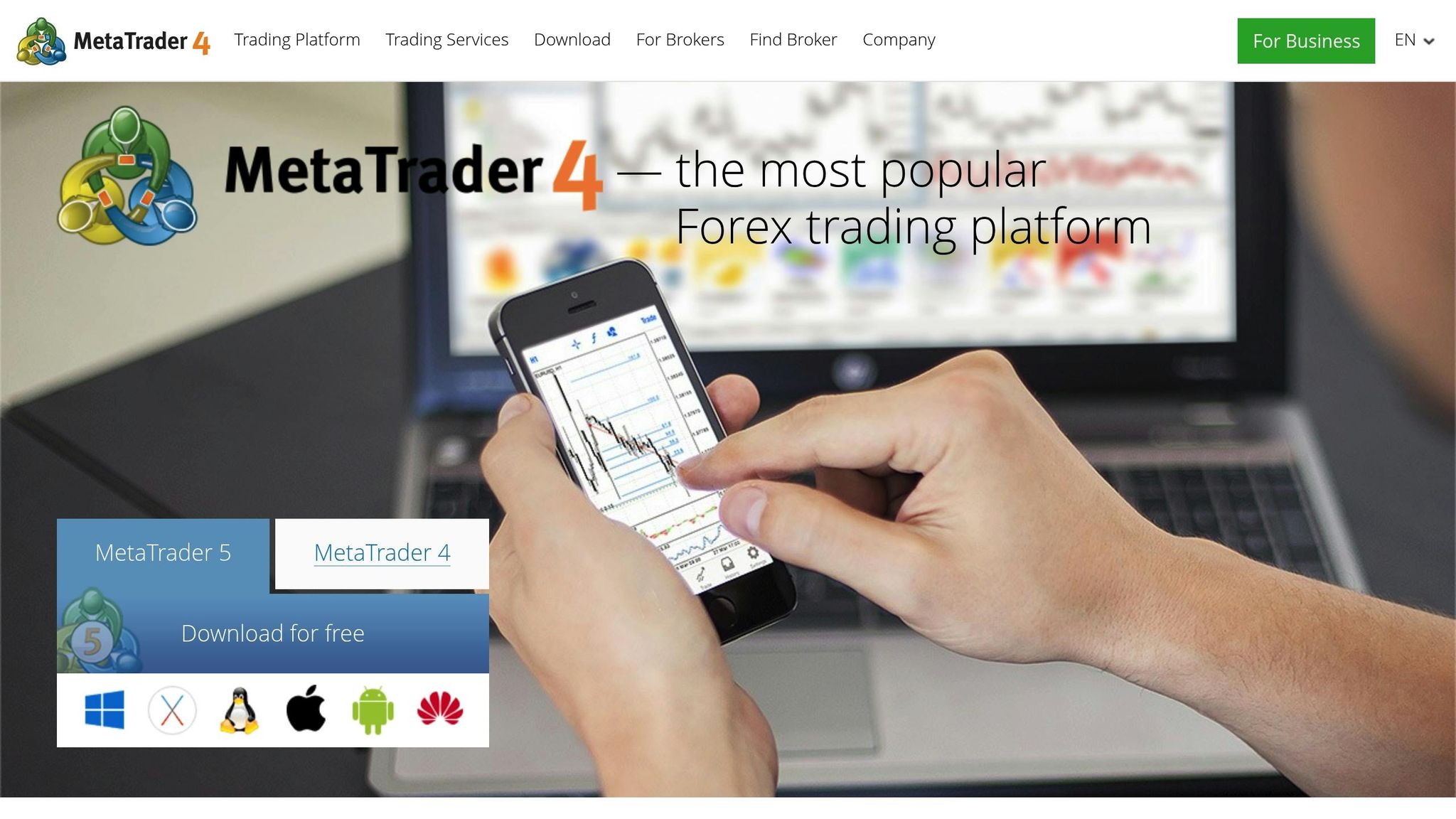
MetaTrader 4 (MT4) has long been a trusted forex trading platform, particularly for its reliable copy trading features. Despite being around for quite some time, MT4 remains a go-to option for professional traders managing multiple accounts. Its flexibility and reliability make it a solid choice for those who prioritize stability in account replication. Let’s take a closer look at how its copy trading mechanisms work and what sets it apart.
Copy Mechanism
MT4’s copy trading system relies on two main methods: Expert Advisors (EAs) and API-driven solutions. EAs are automated trading programs written in MQL4, designed to track the activity of a master account and replicate trades across multiple slave accounts. These programs can use file sharing, cloud-based systems, or direct broker API connections to communicate. This setup allows traders to fine-tune elements like position sizing, risk controls, and trade filtering.
Synchronization times generally range from 100 to 500 milliseconds, depending on the network setup and server locations. For those using QuantVPS hosting, these times can be reduced significantly, thanks to optimized infrastructure and proximity to major forex data hubs.
Supported Assets
MT4’s versatility extends beyond its core forex trading capabilities. While the platform primarily handles forex pairs and CFDs, many brokers now offer additional options, including commodities, indices, and even some cryptocurrencies. Typically, MT4 supports over 50 major and minor currency pairs, along with precious metals like gold and silver. Although it wasn’t originally built for futures trading, some brokers provide futures-like instruments through CFDs, broadening its appeal.
This diverse range of supported assets makes MT4 a strong choice for traders employing strategies that span from EUR/USD scalping to gold swing trading.
Latency and Execution Speed
The speed of execution in MT4 copy trading setups largely depends on the hosting environment and broker infrastructure. Standard configurations may experience delays of 200 to 800 milliseconds between master and slave account executions. However, professional setups, especially those using high-performance VPS solutions like QuantVPS, can achieve replication times under 100 milliseconds. This improvement comes from dedicated resources, optimized network routing, and close proximity to broker servers – key factors for traders using high-frequency or scalping strategies.
Ideal Use Case
For prop traders and portfolio managers, MT4 offers the reliability and precision needed to scale funded accounts effectively. It’s particularly well-suited for forex-focused prop firm environments and portfolio management scenarios where proven strategies need to be applied across multiple accounts. Firms like Apex, MFFU, and FundedNext often support MT4-based setups for their funded traders.
The platform is also a great fit for discretionary traders who execute trades on a master account while automatically mirroring them across multiple slave accounts. This setup allows experienced traders to handle larger capital allocations without the hassle of manually repeating trades.
Algorithmic traders also find MT4’s copy trading features valuable. By deploying the same EA across several broker accounts or separating signal generation from execution, they can streamline their operations. Additionally, MT4’s robust backtesting tools enable traders to thoroughly test their strategies before going live, ensuring better performance and reduced risk.
4. MetaTrader 5 (MT5)
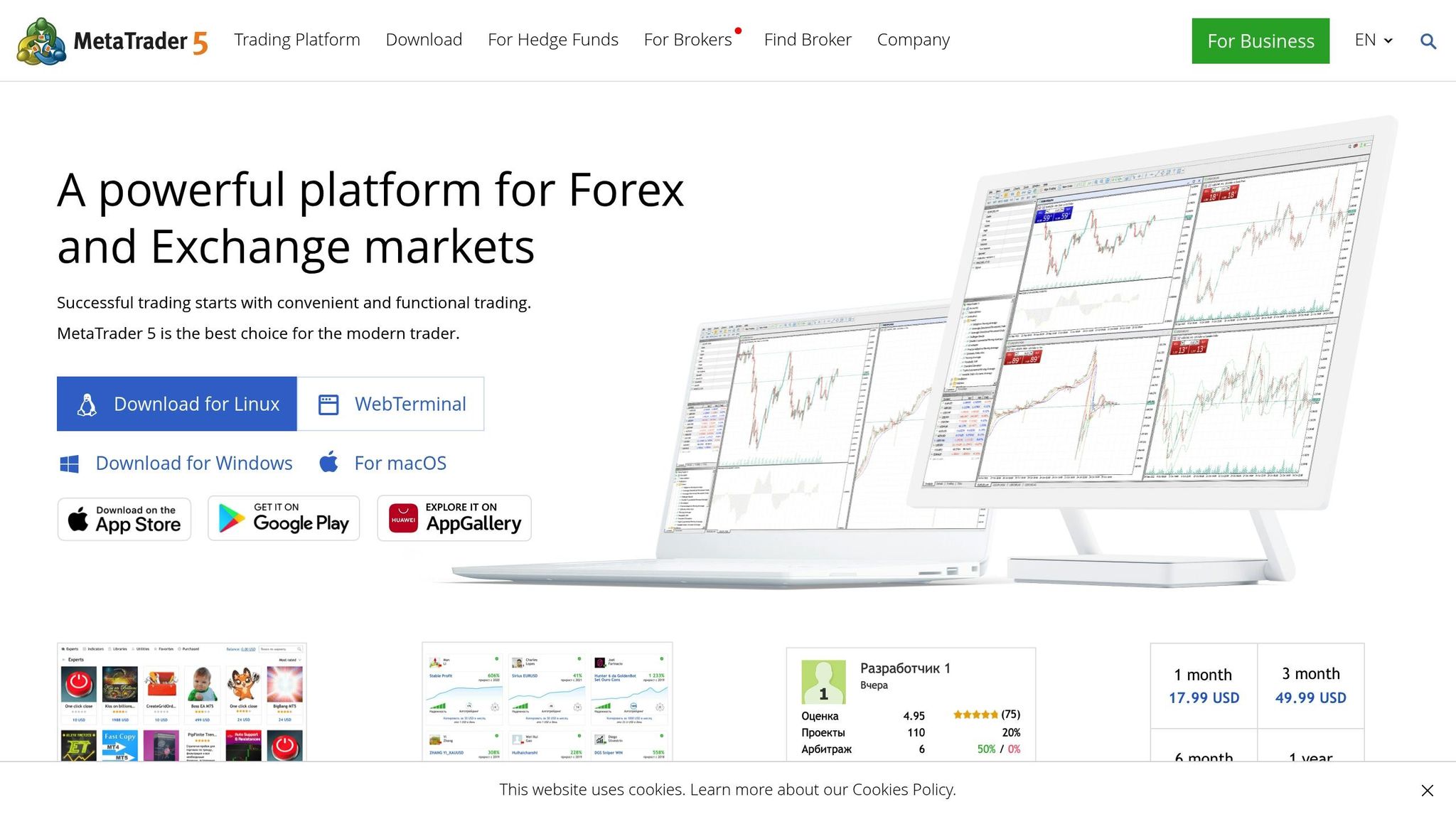
MetaTrader 5, or MT5, takes trading to another level with its multi-asset capabilities and advanced tools for copy trading. While MT4 is still a favorite for forex traders, MT5 has carved out a space for itself among professionals who need access to a wider range of markets and more sophisticated automation options. Its built-in community signal network and the upgraded MQL5 programming language make it especially appealing for algorithmic traders and portfolio managers working across multiple funded accounts. Let’s explore how MT5 handles copy trading, its asset offerings, execution performance, and key use cases.
Copy Trading Mechanics
MT5 uses a dual approach to copy trading, combining local Expert Advisors (EAs) with cloud-based signal services. The platform’s Signals service lets users subscribe to signals from verified providers, automatically executing trades across multiple accounts. This system leverages MetaQuotes’ cloud infrastructure, achieving trade replication speeds between 50 and 200 milliseconds.
For more tailored setups, traders can create custom MQL5 Expert Advisors to manage master-slave account relationships. These EAs can communicate via file sharing, databases, or direct API calls. Thanks to MQL5’s faster execution and improved memory handling compared to MQL4, it’s a better fit for high-frequency copy trading.
Professional traders often mix both methods – using the native Signals service for distributing strategies while employing custom EAs to fine-tune risk management and position sizing. On dedicated VPS hosting, these setups can achieve synchronization speeds under 100 milliseconds, ensuring precision and efficiency.
Asset Coverage
One of MT5’s standout features is its multi-asset framework, which supports a broad range of instruments. Traders can access forex pairs, stocks, futures, commodities, indices, and cryptocurrencies through a single platform. Most brokers offering MT5 provide access to over 100 currency pairs, major stock exchanges like NYSE and NASDAQ, and popular cryptocurrency pairs such as BTC/USD and ETH/USD.
The platform’s Market Depth feature delivers Level II pricing for supported instruments, offering insights into order flow and liquidity. This is particularly helpful for futures traders who rely on understanding market microstructure when applying copy trading strategies across accounts.
Unlike MT4, which primarily focuses on CFDs, MT5 also supports real stocks and exchange-traded futures, making it a better choice for institutional-grade trading operations. This versatility allows traders to execute precise copy trading strategies across a variety of markets. For prop firm traders, this direct market access is invaluable for meeting execution requirements while scaling strategies across funded accounts.
Latency and Execution Performance
MT5’s optimized architecture ensures latency of 50 to 300 milliseconds, thanks to its improved networking and memory management. For professional setups, using dedicated VPS hosting can further reduce latency. Hosting solutions like QuantVPS, which are fine-tuned for MT5, often deliver replication speeds under 100 milliseconds. The platform’s ability to process multiple data feeds simultaneously without performance drops makes it ideal for managing diverse asset classes in copy trading.
While MT5 includes a built-in Virtual Private Server (VPS) option for basic hosting, serious traders often choose dedicated hosting solutions for greater control over latency and uptime. Proximity to broker servers is a key factor, with hosting locations in Chicago or New York offering optimal performance for most US-based traders and prop firms.
Best Use Cases
MT5 shines in multi-asset portfolio management, making it a go-to platform for traders replicating strategies across different types of instruments. Prop firms like MFFU and FundedNext increasingly support MT5, as it allows traders to diversify beyond forex into stocks and futures. Its extensive market access is a big advantage for algorithmic traders working on cross-asset momentum or arbitrage strategies.
For discretionary traders managing several funded accounts, MT5’s advanced order management and charting tools are a game-changer. The platform’s ability to handle complex strategies while maintaining accurate copy ratios makes it ideal for sophisticated trading approaches.
The integrated MQL5 Market offers thousands of trading robots and indicators, enabling traders to quickly deploy tested strategies across their accounts. This ecosystem is particularly useful for portfolio managers scaling successful strategies while ensuring consistent risk management.
For quantitative traders, MT5’s enhanced backtesting engine and strategy optimization tools provide a solid foundation for validating copy trading setups before going live. Features like walk-forward analysis and Monte Carlo simulations help ensure that strategies remain reliable across varying market conditions.
5. TradeStation
TradeStation is a trading platform designed with professionals in mind, known for its powerful automation tools and strategy development capabilities. At the heart of the platform is the EasyLanguage programming environment, which provides a flexible way to create, test, and refine automated trading strategies. While specific details about its copy trading features aren’t widely publicized, traders often use EasyLanguage scripting in combination with third-party tools to replicate trades across multiple accounts. This functionality makes it a strong choice for managing multi-account strategies in professional settings.
Beyond automation, TradeStation delivers extensive market access, dependable trade execution, and advanced charting tools. These features make it an attractive option for algorithmic traders, portfolio managers, and proprietary trading firms looking to scale their operations and implement sophisticated trading systems efficiently.
6. Sierra Chart
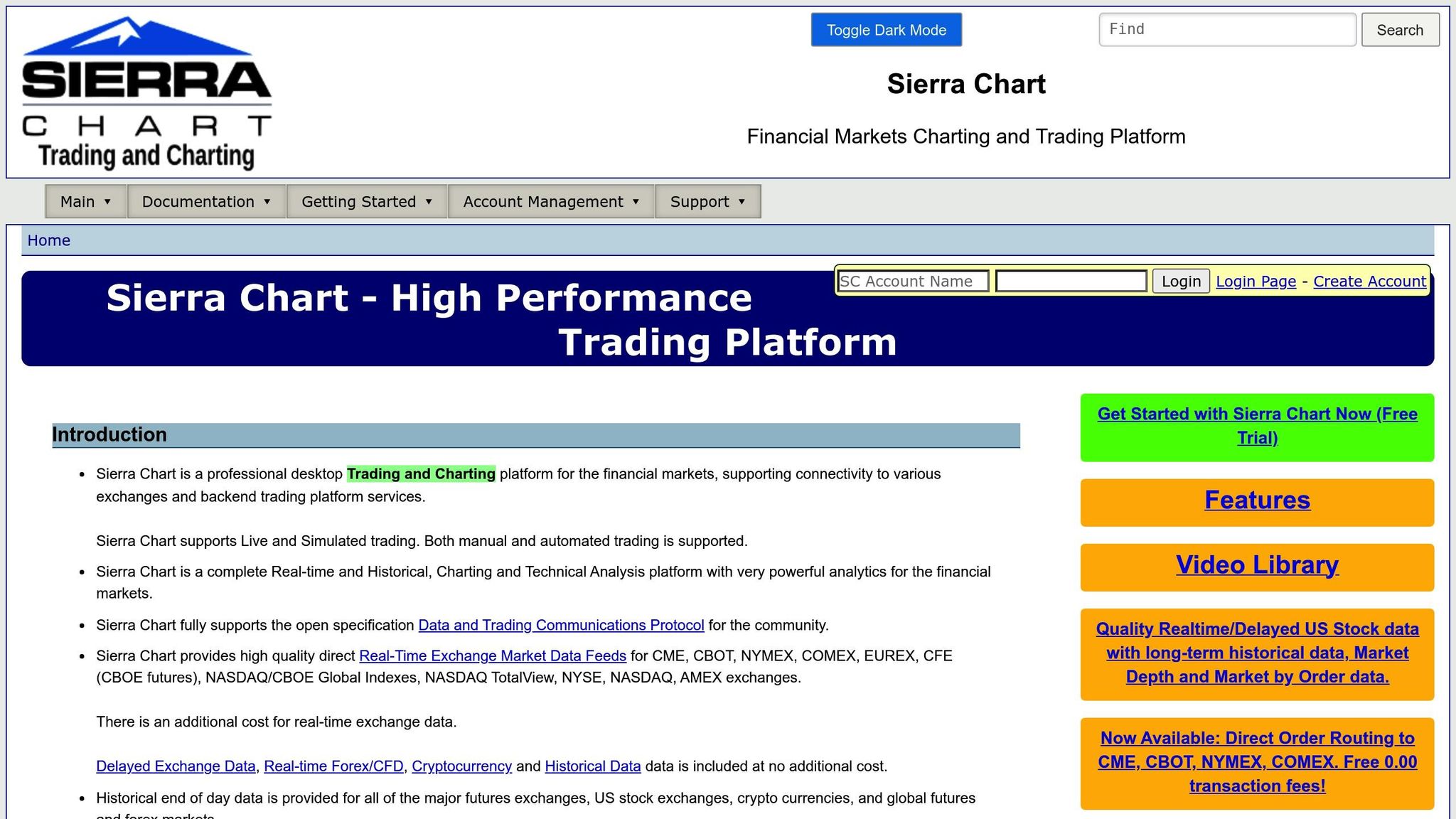
Sierra Chart is a high-level futures trading platform widely used by proprietary trading firms and algorithmic developers. Built to handle the demands of the futures market, it offers tools for in-depth analysis and efficient multi-account management. Many traders pair Sierra Chart with third-party trade copying tools to replicate trades across multiple accounts. This integration ensures smooth and accurate multi-account trading.
Copy Mechanism
Sierra Chart works seamlessly with external copy trading tools to enable near real-time trade execution. These third-party solutions allow users to replicate trades across different accounts using either local or network-based setups, giving traders a flexible and efficient way to manage multiple accounts.
Supported Assets
The platform is specifically tailored for futures trading, making it a go-to choice for traders active on major exchanges like the CME. It includes features that address the unique needs of futures markets, such as margin management and contract rollovers. While Sierra Chart can be configured for other asset types, its primary focus remains on delivering robust support for futures trading.
Ideal Use Case
Sierra Chart is a great fit for proprietary traders and algorithmic developers handling multiple funded accounts. By combining the platform with third-party trade replication tools, traders can efficiently mirror trades while maintaining a strong focus on risk management and strategic objectives. This setup is particularly useful for firms and individuals looking to streamline their operations across multiple accounts.
7. Bookmap
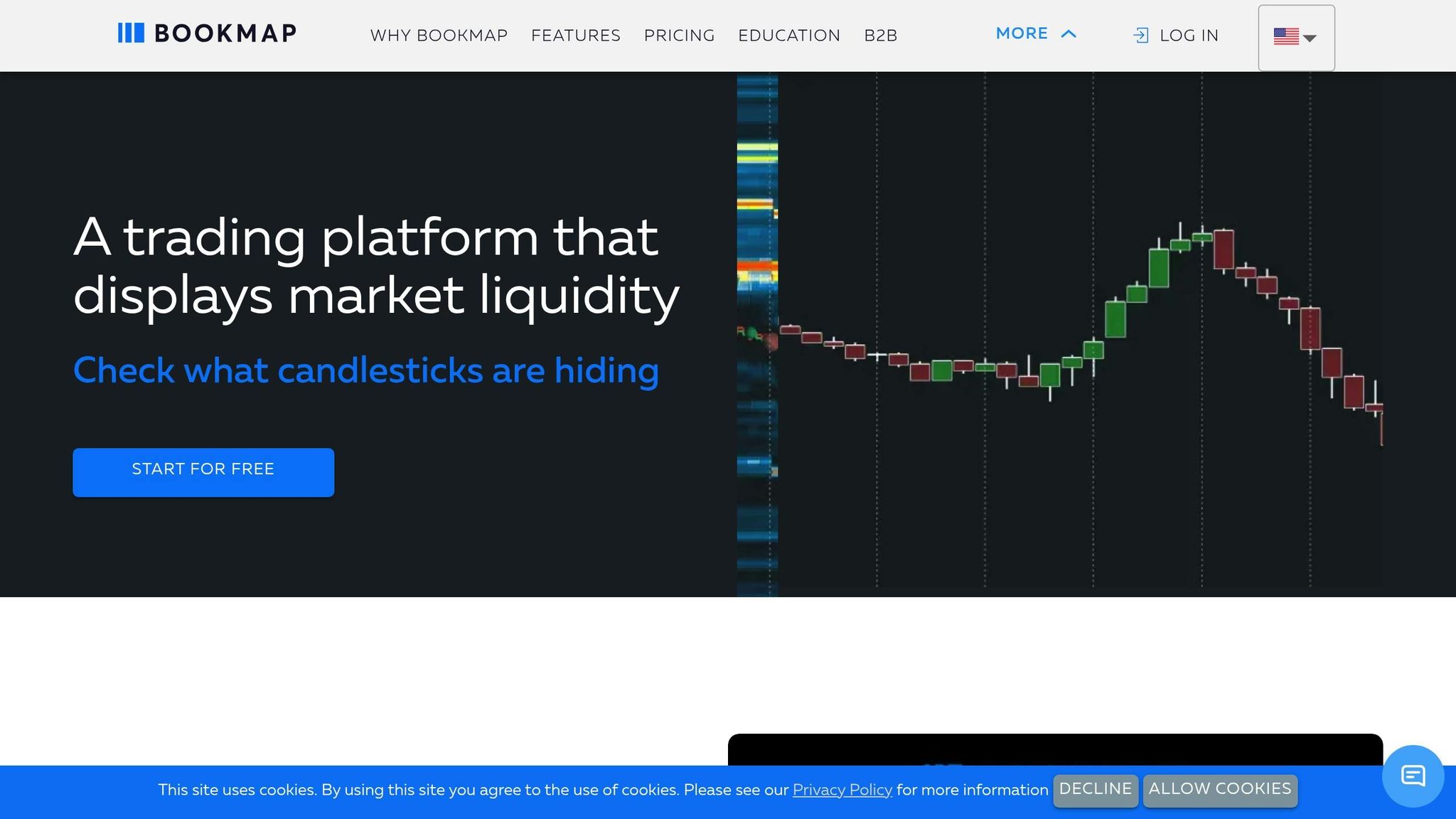
Bookmap stands out as a visual order-flow trading platform that prioritizes precision and real-time execution. It transforms market analysis by presenting data through a dynamic heatmap that showcases order flow, volume, and liquidity as they happen. This tool is particularly valuable for traders looking for detailed insights into the market’s microstructure.
What sets Bookmap apart is its ability to uncover market dynamics that traditional charts often overlook. By visualizing where significant orders are placed and tracking liquidity changes throughout trading sessions, the platform helps traders identify potential support and resistance levels based on actual order flow patterns.
Supported Assets
Bookmap primarily focuses on the futures market, offering order flow visualization using data from major exchanges like CME, ICE, and Eurex. While its tools are designed with futures in mind, they can also be adapted for other asset classes, including equities and cryptocurrencies, provided users have compatible data feeds. However, information about its copy trading features remains somewhat limited.
Latency and Data Considerations
To deliver accurate real-time visualizations, Bookmap depends on fast and stable data feeds. This means traders need to ensure their hosting and connectivity setups are optimized for smooth and timely data delivery. Without reliable data, the platform’s ability to capture detailed market activity could be compromised.
Ideal Use Case
Bookmap is a powerful resource for professional traders aiming to deepen their understanding of market dynamics through order flow analysis. Its visual tools highlight liquidity shifts and market inefficiencies, helping users refine their strategies. Algorithmic traders and developers often use Bookmap to validate their models, aligning their quantitative strategies with actual market behavior in real time.
8. Replikanto
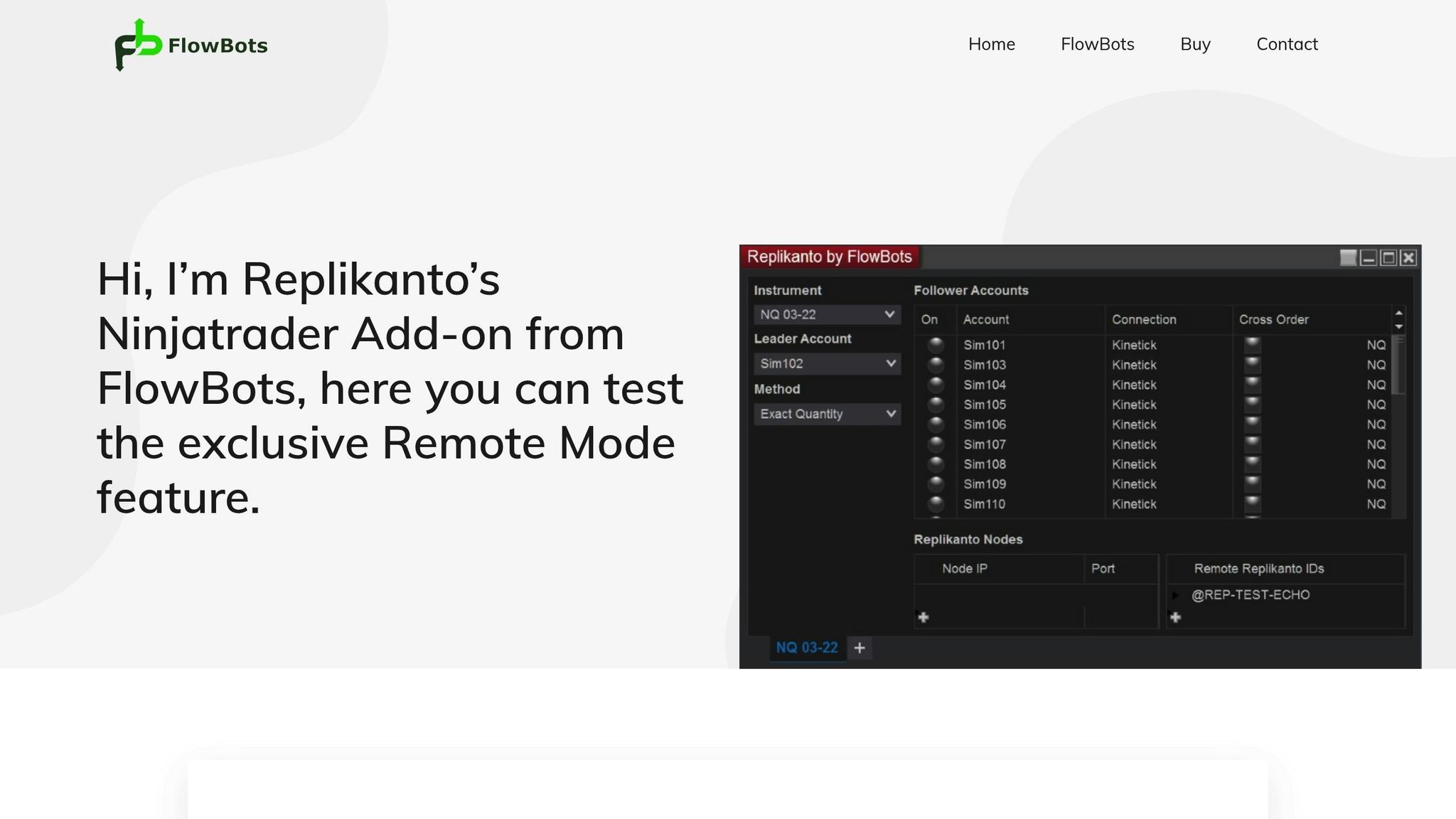
Replikanto is a trade copier designed specifically for NinjaTrader, making it easier for traders to replicate trades from a lead account to multiple connected accounts. It’s tailored for those who rely on pre-built strategies, focusing solely on trade duplication without adding unnecessary features.
Unlike tools packed with analytical or market data functionalities, Replikanto keeps things simple. It sticks to its core purpose: duplicating trades efficiently for strategies already configured within NinjaTrader.
While details about its operational mechanics and latency aren’t publicly documented, its real-world performance can only be gauged through live use. Replikanto fits seamlessly into a trader’s workflow, simplifying the process of mirroring trades across accounts.
9. CrossTrade
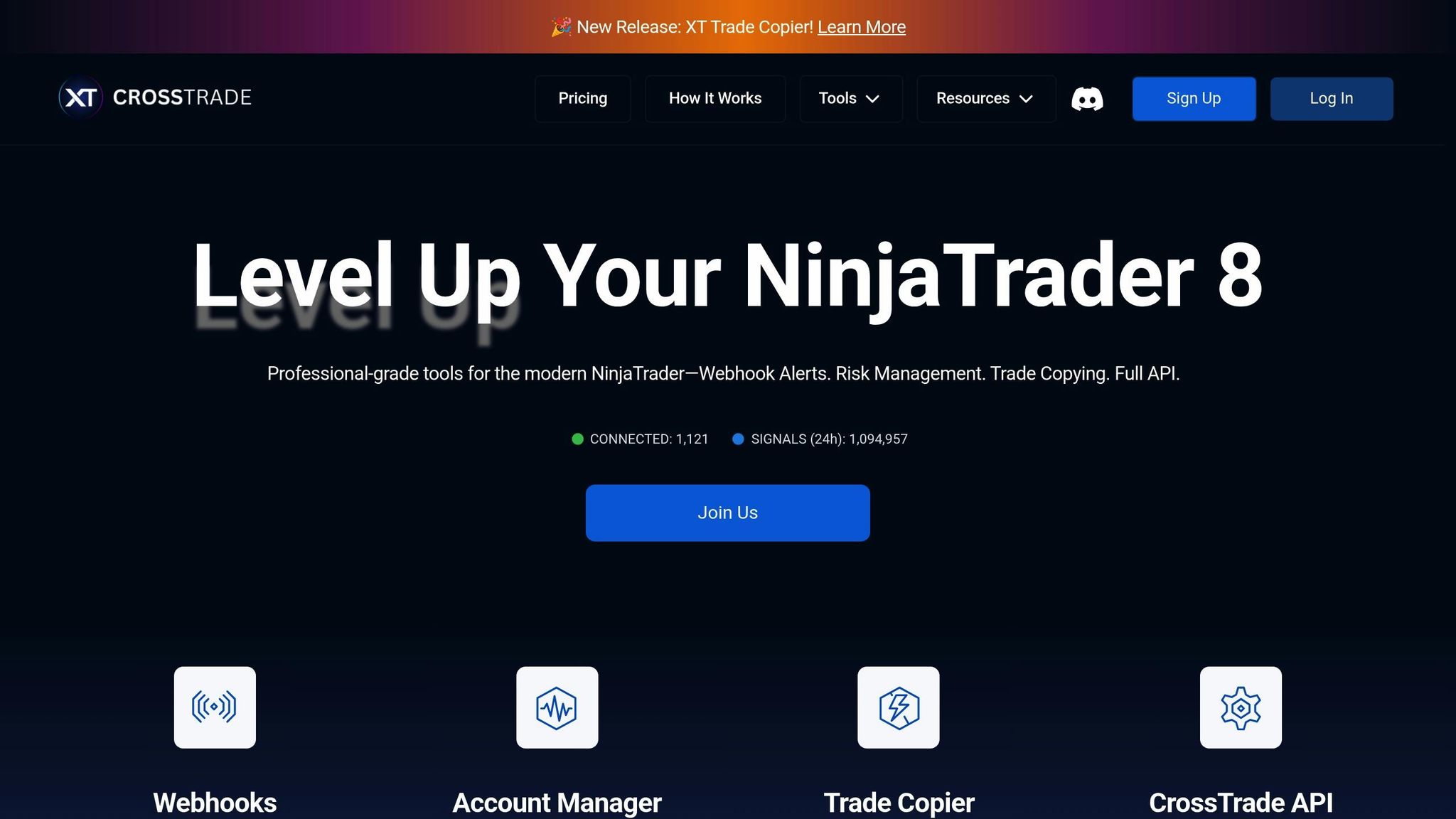
CrossTrade is designed to keep up with the trading industry’s move toward cloud-based, professional-grade tools. This trade copier operates entirely in the cloud, eliminating the need for local installations or self-managed VPS setups. It integrates seamlessly with both NinjaTrader and Tradovate platforms, making it a powerful choice for managing multi-account strategies.
One of its standout features is its execution speed. With an average latency of just 20–30 milliseconds, thanks to strategically placed servers near broker infrastructure, CrossTrade delivers the kind of speed that prop-firm and algorithmic traders rely on. In fast-paced trading environments, even minor delays can lead to slippage, but CrossTrade’s low-latency performance ensures smooth execution across multiple accounts.
Copy Mechanism
CrossTrade’s trade copier system is fully cloud-based, requiring no local software or Expert Advisors. Trades between master and follower accounts are automatically synchronized using secure cloud infrastructure, ensuring consistent execution across all connected accounts. Features like stealth mode, trade inversion, and Auto-Sync make it easy to keep all accounts aligned without manual intervention.
Supported Assets
The platform focuses primarily on futures and forex trading. Through its NinjaTrader integration, it supports commodity and index futures, while its Tradovate connectivity caters to major currency pairs. This targeted approach ensures optimized execution speed and reliability for traders working in these markets.
Latency and Execution Speed
With execution latency averaging 20–30 milliseconds, CrossTrade is designed to minimize slippage – an essential factor for multi-account trading and high-frequency strategies. This near-instantaneous execution is particularly beneficial for algorithmic traders and prop-firm operations where timing is everything.
Ideal Use Case
CrossTrade is an excellent choice for prop-firm traders managing multiple funded accounts, offering precise trade synchronization and allowing for tailored risk management. Algorithmic traders can take full advantage of its high-frequency trading capabilities, while portfolio managers benefit from advanced tools like trade inversion and scaling to execute complex hedging strategies. With its competitive pricing and professional-grade features, CrossTrade stands out as a reliable solution for traders with demanding requirements.
10. Affordable Indicators Trade Copier
The Affordable Indicators Trade Copier provides NinjaTrader users with a cost-effective way to explore copy trading. Designed as an entry-level option, it’s particularly suited for those testing out multi-account strategies within NinjaTrader’s well-established ecosystem.
While detailed technical specifications are sparse, the tool supports NinjaTrader’s standard instruments, such as futures and forex. However, it’s always a good idea to double-check asset compatibility to ensure it meets your trading needs. The primary purpose of this trade copier is to help users replicate trades across multiple accounts, making it a straightforward choice for traders who don’t need the complexities of more advanced systems.
This tool works best for smaller portfolios or for those in the early stages of experimenting with copy trading. As always, it’s wise to test it in a simulation environment before diving into live trading.
11. ETP Trade Copier
The ETP Trade Copier, created by EliteTraderProgramming, is a tool tailored for traders using the NinjaTrader platform. Its primary function is to replicate trades across multiple accounts, making it particularly useful for those managing several accounts simultaneously.
While specific details about replication methods, supported asset types, and latency aren’t provided, the tool is geared toward professional trading environments, especially for funded account setups. For more information about its technical features and performance, it’s best to reach out directly to EliteTraderProgramming.
12. Duplikium
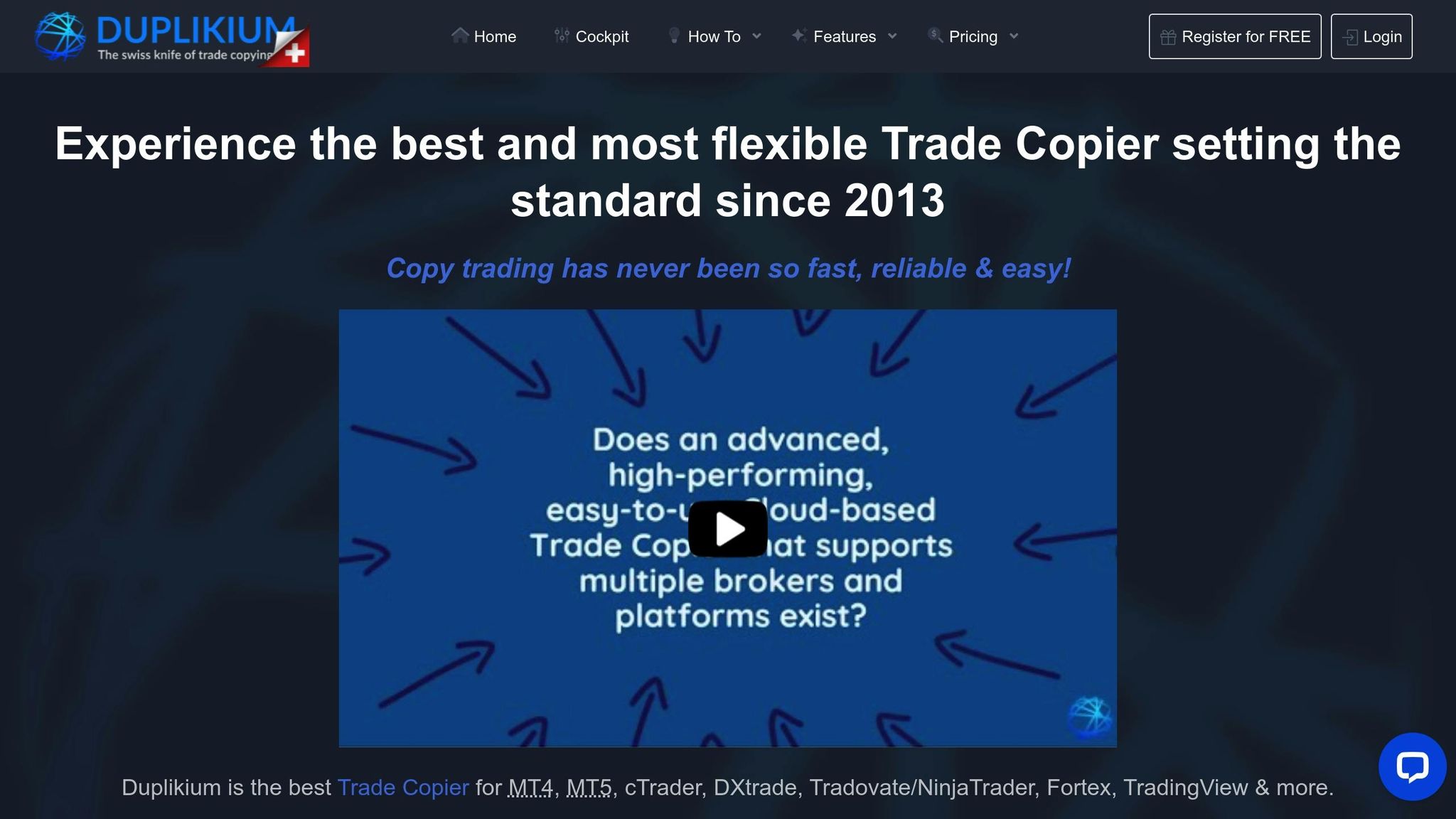
Duplikium is a trade replication platform designed for professional traders. It connects directly to trading accounts through APIs, automating the process of copying trades without the need for manual input. This streamlined approach makes it a powerful tool for those involved in advanced copy trading.
Copy Mechanism: API Integration
Duplikium’s core functionality revolves around its API-based trade replication. By linking directly to trading accounts, it mirrors trades in real time, removing the need for manual execution. Users can fine-tune their settings, deciding which actions or strategies to replicate. This flexibility ensures precise control, making it easy to manage multiple accounts simultaneously. Traders can also choose their preferred signal providers and apply consistent configurations across their portfolios.
Supported Assets: Forex-Centric
While Duplikium’s primary focus is on forex trading, it supports a wide range of currency pairs, including major, minor, and exotic options. It works seamlessly with brokers such as AvaTrade, Pepperstone (via cTrader), and Vantage, offering access to strong liquidity pools. Although currently focused on forex, the platform’s API-based framework leaves room for potential expansion into other asset classes in the future.
Best Fit: Advanced Copy Traders
Duplikium is tailored for experienced traders managing multiple funded accounts. With a minimum deposit requirement of $5,000 and broker-related fees averaging around $100 plus commissions, it’s designed for serious trading rather than casual use. Its customizable copying parameters make it an excellent choice for traders looking to scale their strategies across accounts with varying risk levels.
13. TradeSyncer
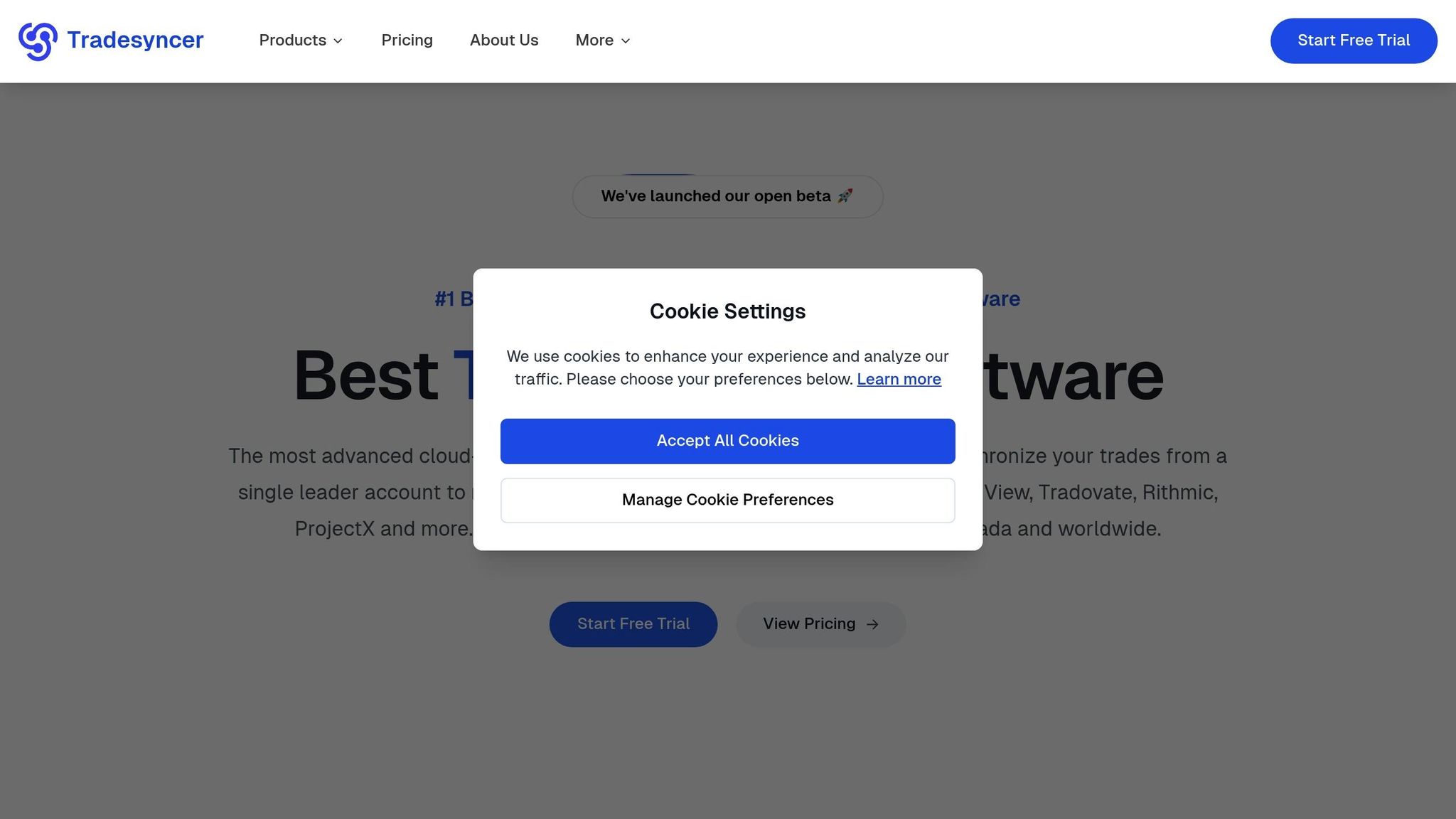
TradeSyncer is a cloud-based trade copier specifically tailored for professional futures trading. Because it operates entirely in the cloud, there’s no need for downloads, and it ensures 24/7 automated synchronization across funded accounts. To date, the platform has successfully copied over 123 million trades across various platforms, showcasing its reliability and efficiency.
"The most advanced cloud-based trade copier for futures trading." – Tradesyncer
This level of performance highlights its precise, API-driven trade replication capabilities.
How It Works: Cloud-Based API Integration
TradeSyncer relies on a cloud-based API system to directly link with trading accounts, enabling real-time trade replication. Its always-on architecture ensures trades are automatically synchronized across all connected accounts. Plus, it’s designed to integrate seamlessly with leading futures trading platforms, making it a hassle-free solution for professionals.
Focused on Futures Trading
This platform is built exclusively for futures trading. By narrowing its focus, TradeSyncer delivers optimized execution speeds and enhanced risk management for futures contracts. Its deep integration with futures brokers and data feeds ensures the precise timing required for executing strategies in this fast-paced market.
Lightning-Fast Execution
With execution latencies clocking in at under 100ms, TradeSyncer is ideal for time-sensitive futures strategies. Its global cloud infrastructure reduces delays, delivering reliability that’s on par with dedicated local hosting solutions.
Who Benefits Most?
TradeSyncer is designed with professional futures traders and proprietary trading firms in mind. For those who prioritize speed, precision, and scalability, this platform provides secure multi-account management, built-in risk management tools, and an automated trading journal. Additionally, it adheres to strict global compliance standards, including GDPR, CCPA, SSL encryption, NIS2, and ISO 27002. To help users get started, TradeSyncer offers a 7-day trial, making it easy to explore its features risk-free.
14. CopyGram
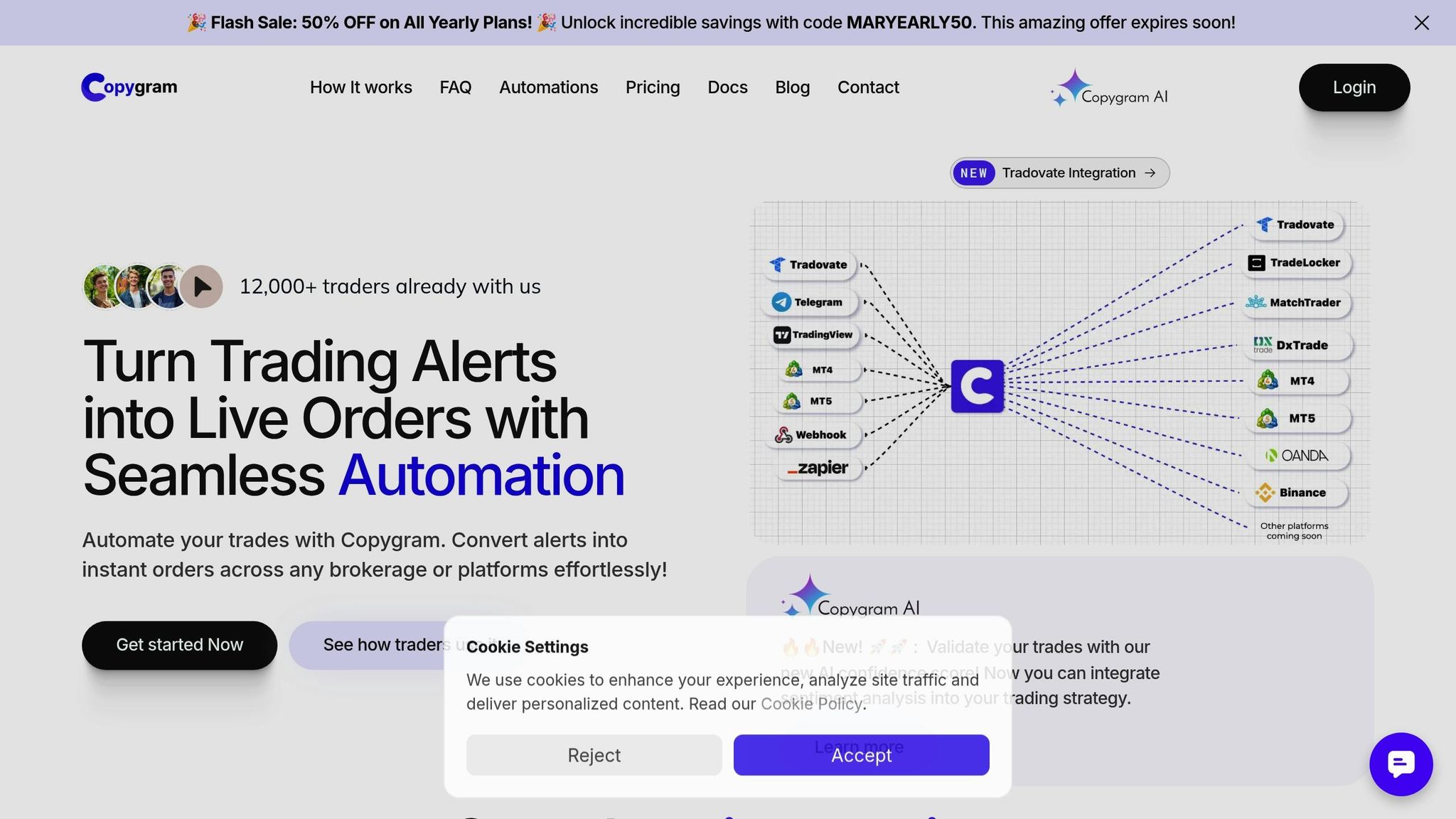
CopyGram brings a cloud-based copy trading solution designed specifically for MetaTrader 4 and MetaTrader 5 users. Leveraging AI powered by ChatGPT, it translates trading signals from Telegram messages into live orders across multiple brokerage accounts, making it easier than ever to automate trades.
Since the platform operates entirely in the cloud, there’s no need to keep your computer running around the clock. Automation is handled seamlessly, 24/7.
How Copying Works (API-Based)
CopyGram uses a two-pronged approach to copy trades, adapting to different platform needs. For most trading platforms, it relies on official APIs to ensure smooth trade transfers between accounts. For MetaTrader 4 and MetaTrader 5, it uses a specialized Expert Advisor (EA) to securely connect accounts.
One standout feature is its "Rooms" functionality, which acts as a hub for trade replication. Traders can link multiple accounts to a single room, allowing trades made by a designated sender account to be instantly copied to all connected receiver accounts. This setup ensures efficient trade replication across MetaTrader platforms.
Supported Assets (MetaTrader Integration)
By integrating directly with MetaTrader, CopyGram allows traders to follow expert strategies while maintaining control over risk parameters. This tight integration also ensures quick and reliable order execution.
Speed and Latency
CopyGram excels in delivering trades instantly across all connected accounts. Its cloud-based infrastructure reduces latency, a common problem with local copying systems. This speed is especially critical when processing external signals, where even small delays can significantly impact trading results.
Who Benefits Most (Prop Firms and Signal Automation)
CopyGram is a great fit for prop firms and algorithmic traders. It works well in environments like Apex Trader Funding, where centralized trade management is key.
For algorithmic traders, CopyGram supports Expert Advisors, enabling automated strategies to run across multiple accounts while staying under one management system. Additionally, for those who depend on external alerts – like Telegram channels or TradingView signals – the platform’s AI-driven signal parsing ensures trades are executed quickly and accurately.
15. cTrader Copy
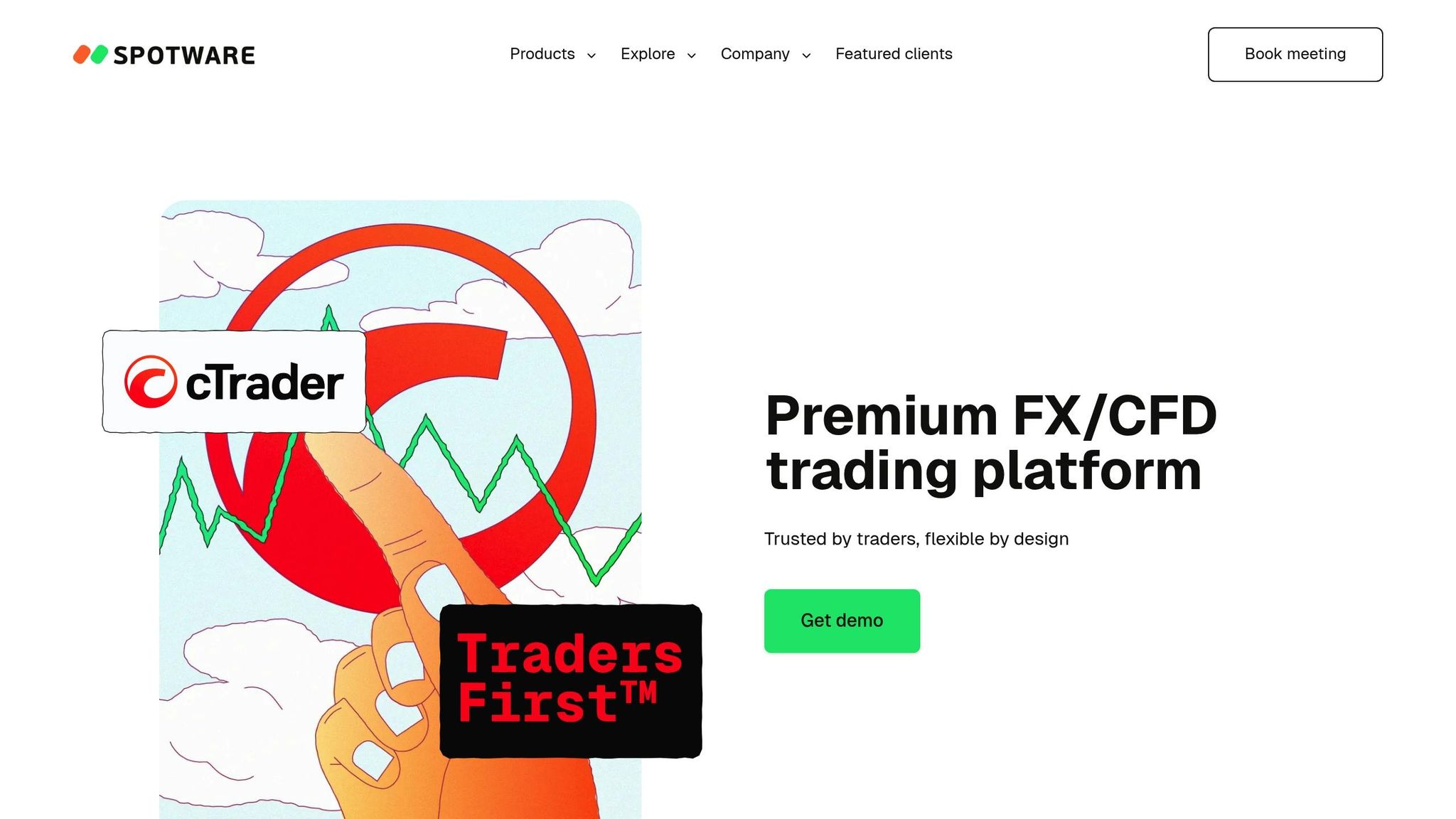
cTrader Copy is a built-in feature of the cTrader platform that enables copy trading directly through participating brokers. Since it’s integrated into the platform, there’s no need for additional installations or external tools.
This system operates on a strategy provider model, where seasoned traders share their strategies, and followers replicate them automatically. Followers can customize risk settings, making it easier to manage exposure. By being fully integrated, cTrader Copy removes much of the hassle and technical hurdles often seen with standalone copy trading solutions.
Copy Mechanism: How It Works
cTrader Copy leverages cTrader’s cloud infrastructure for seamless, server-level trade replication. When a strategy provider places a trade, it’s distributed to all follower accounts within milliseconds. This server-side copying means followers don’t need to keep their trading platforms running all the time.
The system adjusts trade sizes proportionally, based on each follower’s account balance and risk preferences. Risk management tools, such as maximum drawdown limits and daily loss thresholds, allow followers to tailor their involvement safely.
Supported Assets: Diverse Trading Opportunities
One of the standout features of cTrader Copy is its support for a wide range of assets available on the cTrader platform. These include forex, commodities, indices, and cryptocurrencies, allowing traders to diversify across multiple markets.
The platform also supports fractional lot copying, ensuring that trades are scaled appropriately for accounts of all sizes. This proportional scaling ensures smaller accounts can participate without being overexposed.
Speed and Precision in Execution
Speed is a critical advantage of cTrader Copy. Since the trade replication happens within cTrader’s infrastructure, execution is nearly instantaneous – within milliseconds. This is especially valuable for strategies that depend on precise timing, such as those used during volatile market conditions.
Trades are processed through the same liquidity providers as the original strategy, ensuring consistent pricing and minimizing slippage. This level of precision helps maintain alignment between the master and follower accounts.
Who Benefits Most?
cTrader Copy is particularly well-suited for portfolio managers and proprietary trading firms. It simplifies multi-account replication while offering built-in compliance tools and detailed reporting, making it easier to maintain transparency with clients and meet regulatory standards.
For prop firms, the platform provides an efficient way to scale successful strategies across multiple funded accounts. Proportional risk controls ensure that trades align with predefined risk parameters.
Algorithmic traders also gain significant advantages. When automated systems like Expert Advisors or cBots generate trades on a master account, those trades are instantly copied across follower accounts, eliminating the need for separate automation setups. This makes it a powerful tool for anyone looking to replicate algorithmic strategies efficiently.
16. Tradovate Cloud Copier (via CrossTrade integration)
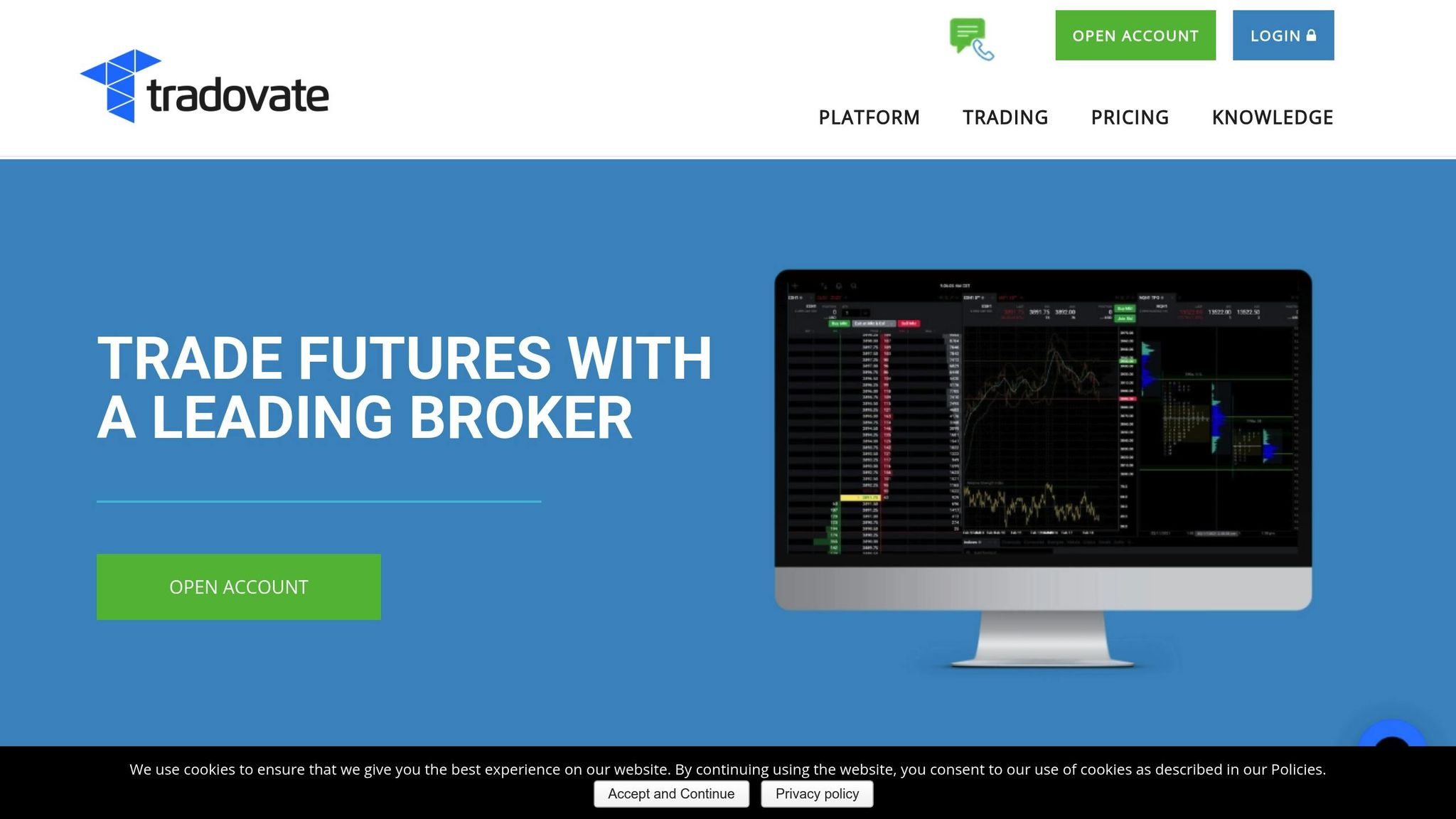
Tradovate Cloud Copier, powered by CrossTrade integration, offers a professional-grade trade replication system tailored for futures traders. It’s fully browser-based, eliminating the need for desktop installations, and is perfect for those managing strategies across multiple funded accounts. By turning Tradovate’s web platform into a comprehensive copy trading solution, it allows prop firm traders and algorithmic futures experts to handle multiple accounts from various locations while ensuring consistent and reliable trade execution. Below, we’ll dive into its replication process, supported assets, speed performance, and why it’s a great fit for professional trading setups.
Copy Mechanism: Cloud-Based Replication
Unlike traditional desktop-based trade copiers, this tool is designed specifically for the web-based Tradovate platform. While detailed documentation is sparse, the system uses a cloud-based infrastructure to replicate trades quickly and efficiently. This eliminates the need for software installations, offering a streamlined experience that aligns with the demands of professional trading environments.
Supported Assets: Focus on Futures Contracts
Tradovate’s expertise lies in futures trading, and the copier reflects this focus. It supports a variety of futures contracts, including popular instruments like the E-mini S&P 500, crude oil, gold, and more. Whether you’re a day trader or prefer swing trading, this platform caters to a wide range of futures strategies.
Latency and Execution Speed
With execution speeds averaging 20–30 milliseconds, the cloud-based infrastructure ensures fast and dependable trade replication. The system relies on low-latency messaging and strategically placed servers to maintain high performance, even during periods of intense market activity. Its browser-based design eliminates the need for local setups, keeping performance stable under volatile conditions.
For traders seeking even faster execution, pairing this system with QuantVPS hosting – offering ultra-low latency (0–1 ms) to major data centers – can further enhance performance, making it an excellent choice for high-frequency trading strategies.
Ideal Use Case: Managing Prop Firm Portfolios
Tradovate Cloud Copier is particularly well-suited for prop firms looking to scale successful strategies across multiple funded accounts. Its browser-based interface simplifies account management, making it especially useful for algorithmic futures traders deploying strategies across different prop firms. This tool makes managing complex portfolios easier, all while ensuring consistent trade execution across accounts.
17. QuantConnect
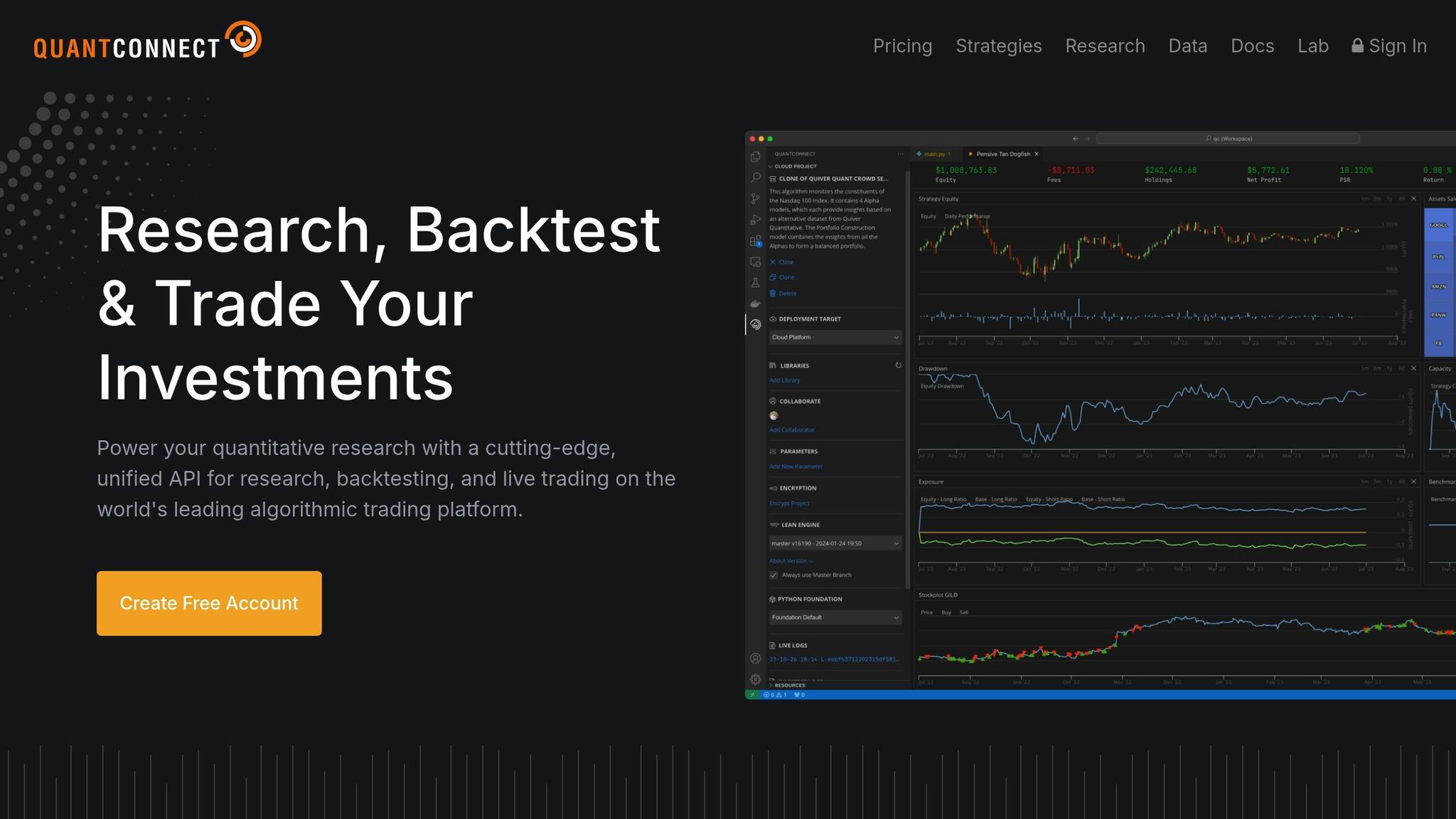
QuantConnect is a cloud-based platform designed for developing, testing, and deploying algorithmic trading strategies. It’s widely used by quantitative developers and institutional traders who value its reliable tools for backtesting and systematic strategy creation. While it doesn’t focus on copy trading, QuantConnect excels in supporting scalable, algorithm-driven strategies across various asset classes.
What sets QuantConnect apart is its flexibility. It allows traders to thoroughly test their strategies in simulation before moving to live trading. This ensures strategies are fine-tuned and ready for real-world application. Though it lacks dedicated copy trading features, its robust environment makes it a go-to for those building and scaling systematic strategies.
For optimal performance and seamless execution in funded accounts, consider pairing QuantConnect with specialized hosting solutions like QuantVPS. This combination helps maintain reliable connectivity and smooth trading operations.
18. MultiCharts
MultiCharts is a professional-grade trading platform tailored for traders who demand advanced analytics and dependable execution. It’s particularly well-suited for those working with sophisticated strategies, thanks to its PowerLanguage scripting environment. This feature allows users to design and implement complex trading algorithms while maintaining a high level of analytical precision.
Traders can craft custom strategies using PowerLanguage (similar to TradeStation’s EasyLanguage) or integrate third-party tools to mirror accounts. This adaptability is especially appealing for algorithmic developers looking to scale strategies across multiple accounts without sacrificing access to detailed analytical tools.
Copy Mechanism (Local, Network, or API-based)
MultiCharts facilitates copy trading through custom APIs and PowerLanguage scripts. The PowerLanguage environment enables developers to build advanced trade replication systems that monitor master accounts and execute corresponding trades on follower accounts. This setup gives traders precise control over timing, position sizing, and risk management.
The platform supports both local and network-based copying. Local configurations are ideal for managing trades on a single workstation, while network setups allow for distributed trading across various locations. API connectivity ensures swift processing of trade signals, with execution speeds typically under 50 milliseconds when systems are properly optimized. This seamless replication aligns with MultiCharts’ robust data and execution capabilities.
Supported Assets (Futures, Forex, Stocks, Crypto)
MultiCharts provides extensive asset coverage, including futures, forex, stocks, and cryptocurrencies. It connects with major data providers like Interactive Brokers, CQG, Rithmic, and eSignal, offering access to real-time market data from global exchanges. Futures traders, in particular, benefit from its strong integration with CME Group products and other leading derivatives exchanges.
The platform supports major currency pairs and exotic crosses via multiple liquidity providers, accommodating both spot forex and currency futures. Stock trading includes coverage of major U.S. exchanges such as NYSE and NASDAQ, as well as regional markets, supporting both cash and margin accounts. These capabilities make MultiCharts a versatile tool for diverse trading strategies, especially when combined with its advanced replication features.
Latency and Execution Speed
Execution speed on MultiCharts depends on broker connectivity and hosting optimization. When paired with low-latency hosting solutions, the platform can achieve execution times under 100 milliseconds for most order types. Its architecture supports direct market access (DMA) through compatible brokers, minimizing delays caused by routing.
For traders implementing copy trading across multiple accounts, network latency is a critical factor. Hosting the platform near major financial hubs, such as Chicago or New York, ensures optimal connectivity to U.S. futures and equity markets. With optimized virtual private servers (VPS), execution latency can be reduced to under 50 milliseconds, enhancing performance across all trading activities.
Ideal Use Case (Prop Firms, Algorithmic Traders, Portfolio Managers)
MultiCharts is a go-to platform for algorithmic traders, particularly those who require robust backtesting alongside live execution. Its PowerLanguage scripting environment supports the development of intricate strategies, while the execution engine enables real-time trade replication across multiple accounts. This makes it an excellent choice for traders scaling algorithms to funded accounts.
Portfolio managers benefit from its systematic strategy deployment and detailed performance reporting. The platform’s reporting tools help with compliance and client documentation, while its copy trading capabilities streamline strategy implementation across various client accounts.
For proprietary trading firms, MultiCharts offers the reliability and feature set needed for professional trading operations. Its compatibility with multiple data feeds and brokers makes it well-suited for firms managing diverse strategies across different markets and time frames.
19. StrategyQuant X
StrategyQuant X is a platform tailored for traders who want to create and automate trading strategies. It allows users to export strategy code compatible with multiple platforms like MetaTrader, NinjaTrader, and TradeStation. This flexibility means traders can maintain a consistent strategy framework across different platforms without starting from scratch each time.
What sets StrategyQuant X apart is its focus on strategy automation rather than live trade replication. Instead of copying trades in real time, it generates and adapts strategy code for implementation. For traders who need instant trade replication across multiple accounts, additional trade-copying tools specific to their platforms would be required.
If you’re looking for more information about its technical features or how it integrates into multi-platform workflows, reaching out to the provider is a good step. StrategyQuant X serves as a valuable tool during the strategy development phase, complementing other solutions designed for live trade execution.
Technical Requirements
When it comes to copy trading, having a solid technical setup is absolutely crucial. Success often hinges on milliseconds and system reliability, and even the smallest delays can lead to costly mistakes. Let’s break down the key technical elements that ensure smooth and efficient multi-account replication.
One of the most important factors in this process is execution latency. The faster a trade executed on a master account can be replicated to follower accounts, the better. Even slight delays can result in price slippage and reduced profits. For example, in 2025, TradeSyncer achieved synchronization speeds under 100ms by using a global infrastructure designed for ultra-low latency. Similarly, Duplikium Trade Copier provides rapid trade replication across thousands of brokers in markets like forex, futures, stocks, and crypto. Another vital aspect is the hosting environment. Home internet connections and personal computers simply don’t cut it for professional setups. That’s where services like QuantVPS come in, offering hosting solutions with 0-1ms latency to major exchanges such as CME, thanks to data centers strategically placed in Chicago and New York.
Consistency in data feeds is another essential piece of the puzzle. If master and follower accounts receive market data at different times or from different sources, trades can become misaligned. Professional setups rely on synchronized data feeds from providers like Rithmic or CQG, ensuring every account operates with identical market conditions at the time of execution.
Scaling across multiple accounts of varying sizes introduces its own challenges, particularly with copy ratio management. For example, if a $10,000 master account executes a 10-contract futures trade, a $50,000 follower account needs to scale that trade proportionally. This requires precise calculations to adjust for account sizes, minimum contract requirements, and margin rules. Tools like Quantower’s Copy Trading Panel and NinjaTrader’s Replikanto integration handle these complexities, ensuring proportional risk management across accounts.
Network stability and redundancy are non-negotiable in professional trading environments. A single network issue during active trading hours can lead to missed trades or partial fills, throwing account synchronization out of balance. QuantVPS tackles this with DDoS protection, automatic failover systems, and 100% uptime guarantees, ensuring uninterrupted operations even during market turbulence or external attacks.
Running multiple platforms simultaneously, such as NinjaTrader, MetaTrader, and Quantower, can strain system resources. This makes system resource allocation critical. Without enough CPU and RAM, delays can occur, impacting trade execution. QuantVPS offers configurations ranging from 4-core setups for basic needs to 24-core systems for intensive, multi-platform environments.
Finally, storage performance plays a key role in maintaining speed and efficiency. Traditional hard drives can slow down tasks like loading charts, accessing historical data, or running complex algorithms. By using NVMe SSD storage, platforms can access data almost instantly, ensuring the rapid response times needed for professional trading.
API Integration and Automation
API integration takes copy trading to the next level, turning basic trade mirroring into fully automated portfolio management. By linking directly to broker infrastructures, API-based platforms enable real-time data exchange and precise execution control across multiple accounts, eliminating the need for manual intervention.
One of the standout advantages of API integration is its ability to manage cross-account risk parameters effectively. Platforms like Quantower showcase this by using their Copy Trading Panel to connect with multiple data providers – such as Rithmic, CQG, and Interactive Brokers – via APIs. This setup allows traders to enforce risk controls across various accounts, including position sizing rules, maximum drawdown limits, and instrument filters. Unlike static copy ratios, these systems dynamically adjust trade sizes in real time, accounting for differences in account equity and margin requirements. This flexibility demonstrates how API integration supports automation, as seen in platforms like CopyGram.
CopyGram highlights how API automation can enhance control by allowing follower accounts to set independent stop-loss (SL) and take-profit (TP) levels. Through its MT4/MT5 API integration, users can configure SL and TP parameters via API calls, ensuring they can cap losses or lock in gains without relying solely on the master account’s strategy. This granular control is particularly valuable for scaling across proprietary firm accounts, which often have varying risk tolerances and drawdown restrictions.
Another example is Duplikium, which uses API automation to provide real-time equity tracking across multiple platforms. Its API endpoints monitor equity and balance changes, enabling traders to meet specific performance criteria, such as drawdown limits or profit targets, when managing funded accounts from firms like Apex or MFFU. This capability is crucial for staying compliant with strict trading rules.
Platforms like TradeSyncer take it further by supporting REST and WebSocket APIs, which enable integration with external risk and analytics tools. Traders can build custom monitoring systems to track performance across dozens of accounts, automatically adjust copy ratios, or pause trade replication when risk thresholds are exceeded. This kind of automation is a game-changer in volatile markets where manual adjustments simply can’t keep up.
API integration also opens doors to strategy sharing and centralized risk management. For example, QuantConnect’s infrastructure goes beyond trade copying by enabling strategy sharing and portfolio mirroring. Its API framework supports the deployment of automated strategies across multiple brokerage accounts while maintaining centralized risk controls and performance tracking. This setup allows professional traders to scale successful algorithms across funded accounts without needing constant manual oversight.
Running these API-heavy systems requires robust hosting solutions. With constant API calls, real-time data processing, and synchronization across platforms, traders need significant computational power and fast storage. QuantVPS caters to these needs with configurations ranging from 4-core setups to 24-core systems, ensuring consistent API performance even in high-frequency trading environments.
Finally, API integration enhances risk management by enabling risk filters. Platforms can programmatically exclude certain instruments, limit position sizes based on volatility, or pause trade copying during news events. These automated screening mechanisms provide an extra layer of protection, ensuring strategies remain aligned with predefined risk parameters.
Using Copy Trading with Prop Firms
Proprietary trading firms have transformed how traders scale their strategies, and copy trading platforms have become an essential tool for managing multiple funded accounts. Firms like Apex Trader Funding, My Forex Funds (MFFU), FundedNext, and Take Profit Trader now support trade copying, enabling seasoned traders to replicate their strategies across different accounts seamlessly.
One of the standout advantages of copy trading is its ability to ensure consistent execution of strategies. Once a trader passes a prop firm evaluation and establishes a profitable approach, they can use copy trading to automatically apply that strategy to additional funded accounts without needing to handle each account manually. For instance, NinjaTrader users often rely on tools like Replikanto or CrossTrade to manage multiple accounts. These tools allow trades executed on a primary account to be mirrored across follower accounts, with position sizes adjusted proportionally. This automation not only saves time but also helps maintain strict risk management protocols.
Risk management becomes even more critical when scaling strategies across multiple accounts, as each prop firm enforces unique rules and standards. Copy trading platforms address these challenges by offering account-specific risk controls. For example, Quantower’s Copy Trading Panel lets traders set customized position sizes and loss limits for each account, ensuring that a poor performance in one account doesn’t jeopardize the entire portfolio. Features like the stealth mode in CrossTrade, which introduces randomized delays in execution, can also simulate organic trading behavior, helping traders stay compliant with prop firm requirements. These tailored risk measures make automated trade replication more reliable and effective.
Another important factor in prop firm trading is symbol mapping. Different firms may use varying contract specifications or naming conventions for the same instruments. Tools like ETP Trade Copier offer advanced symbol mapping capabilities, allowing traders to convert symbols between accounts easily. This ensures consistent risk management across accounts with different equity sizes. Alongside symbol mapping, smooth integration across trading platforms is crucial.
For traders using multiple platforms, cross-platform compatibility is a game-changer. Tools like Duplikium allow trades to be synchronized across platforms – such as using NinjaTrader for futures trading with one firm and MetaTrader for forex with another – making it possible to execute a unified strategy despite platform differences.
Managing performance across several funded accounts can be challenging, but tools like TradeSyncer simplify the process. These tools provide centralized dashboards where traders can monitor key metrics and risk levels for all connected accounts, ensuring they stay on top of their performance.
To handle the technical demands of copy trading, robust and low-latency VPS hosting is essential. Services like QuantVPS offer optimized systems that ensure near-instant trade replication, even during periods of high market volatility, reducing the risk of slippage and maintaining overall efficiency.
Finally, automated compliance features built into modern copy trading platforms help traders avoid rule violations and protect their funded accounts. For instance, safeguards like time-based restrictions and instrument filters can adjust trading activity during uncertain market conditions or when dealing with specific assets. Combined with low-latency execution and reliable hosting, these compliance features help traders maintain adherence to strict prop firm standards while scaling their strategies effectively.
Copy Trading Setup and Safety Tips
Setting up professional copy trading requires precision, speed, and reliable tools to ensure smooth execution and synchronization across multiple accounts. Here’s how to get started while keeping your trades secure and efficient.
Reducing Slippage:
Slippage can eat into your profits when trades are replicated across accounts. To minimize this, choose platforms built for high-performance trading with ultra-low latency. This ensures your trades are executed as close to the intended price as possible.
FIX API for Better Connectivity:
For enhanced stability and faster execution, enable FIX API connectivity. Platforms like cTrader offer this feature to provide direct market access. This allows you to execute large volumes of trades quickly while maintaining security and reducing market impact.
Keeping Accounts in Sync:
Synchronization between master and follower accounts is crucial. Look for trade copiers with near-instant synchronization capabilities to ensure that price differences between accounts are kept to a minimum.
Reliable Hosting Infrastructure:
Stable and fast network connectivity is the backbone of professional copy trading. Using a professional VPS hosting service, like QuantVPS, can ensure ultra-low latency and uninterrupted trading operations. A robust hosting setup is key to maintaining a seamless trading experience.
Conclusion
By 2025, professional copy trading has evolved far beyond the capabilities of standard retail trading platforms. The platforms highlighted in this guide – NinjaTrader, Quantower, and MetaTrader – serve as the backbone for serious traders, prop firm participants, and algorithmic developers who demand precision in trade replication and portfolio scaling.
These platforms remain at the forefront of the professional trading space, offering advanced ecosystems with specialized copy trading tools like Replikanto, CrossTrade, and built-in mirroring features. Their performance shines in high-stakes environments where every millisecond matters.
Modern copy trading tools are designed to tackle the real-world challenges professional traders face every day. Whether it’s managing multiple funded accounts with firms like Apex and MFFU, scaling algorithmic strategies across diverse markets, or keeping portfolios perfectly synchronized, these platforms deliver the speed and reliability that manual trading simply can’t provide. This level of performance also highlights the importance of dependable hosting solutions.
"Clients can also access VPS hosting for low-latency trading on high-performance servers, ensuring an uninterrupted trading experience." – FXEmpire
Infrastructure plays a pivotal role here. QuantVPS offers the kind of support traders need to excel, with ultra-low latency connections, 100% uptime guarantees, and configurations tailored for trading applications. Pairing a professional-grade copy trading platform with high-performance hosting like QuantVPS ensures seamless, precise execution. Together, they create the fast, reliable, and scalable trading environment that today’s markets demand.
Looking ahead, as copy trading technology grows even more advanced, the traders who thrive will be those who invest not only in cutting-edge platforms but also in the infrastructure that ensures they operate at their peak potential.
FAQs
What should professionals look for in a reliable copy trading platform?
When selecting a copy trading platform for professional use, focusing on features that ensure reliability and smooth performance is essential. One of the top considerations is execution speed – platforms with low latency help you avoid slippage and missed trades, which can make a big difference in your results. For uninterrupted trading, VPS hosting is another must-have. Services like QuantVPS provide low-latency hosting tailored for professional traders, ensuring your system runs 24/7 without a hitch.
You’ll also want to opt for platforms with reliable data feeds to ensure accurate trade replication. Look for systems that support proportional risk management, which allows you to scale trades across multiple accounts efficiently. Compatibility with brokers and asset classes is another key factor, especially if you’re involved in algorithmic trading. Platforms that support API integration (such as Rithmic, CQG, or IBKR) offer advanced options for risk control and automation, making them a great fit for professional needs. By choosing a platform that aligns with your trading style and goals, you’ll be better equipped to manage trades effectively and grow your operations with confidence.
How do copy trading platforms achieve fast trade execution with low latency?
Copy trading platforms ensure quick trade execution and minimal delays by utilizing cutting-edge technology and carefully designed infrastructure. Many of these platforms rely on cloud-based systems and low-latency messaging protocols, enabling trades to be mirrored almost instantly. To handle high volumes of activity, they often incorporate multi-threading, which allows them to manage multiple accounts at the same time without sacrificing speed or efficiency.
The location of servers is another crucial factor. By hosting on a VPS close to major financial hubs like New York or Chicago, platforms can significantly cut down latency, often achieving execution speeds in the sub-millisecond range. This setup is particularly important for traders who depend on precise timing and smooth trade synchronization across various accounts.
How does VPS hosting improve the performance of copy trading platforms?
Virtual Private Server (VPS) hosting plays a key role in boosting the performance of copy trading platforms. By offering a fast, stable, and dedicated environment, VPS hosting ensures trades are executed with minimal delay. This reduced latency is essential for copying trades almost instantly, helping to prevent slippage and keep accounts perfectly synchronized.
Take optimized VPS services like QuantVPS as an example. They provide ultra-low latency – ranging from 0 to 1 millisecond – to major trading networks like CME and Rithmic. This makes them an excellent choice for traders who rely on real-time trade replication, including algorithmic traders and those juggling multiple funded accounts. With a dependable VPS, you can count on 24/7 uptime and seamless automation, making it a must-have for professional-level trading setups.








